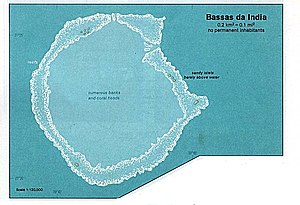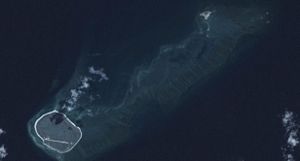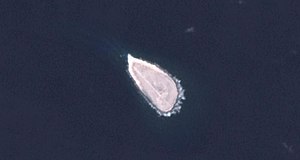Scattered Islands in the Indian Ocean
From Wikipedia, the free encyclopedia.
| This article is in need of attention. You can help Wikipedia by editing it into a better article. Please also consider changing this notice to be more specific. |
| This article is part of the series: Subdivisions of France |
|---|
| Regional level |
| Régions |
| (incl. Overseas régions) |
| Departmental level |
| Départements |
| (incl. Overseas départements) |
| Arrondissement level |
| Arrondissements |
| Cantonal level |
| Cantons |
| Intercommunal level |
| Communautés urbaines |
| Communautés d'agglomération |
| Communautés de communes |
| Syndicats d'agglomération nouvelle |
| Communal level |
| Communes |
| Municipal arrondissements |
| Others |
| Collectivités d'outre-mer |
| Collectivité sui generis |
| Pays d'outre-mer |
| Territoire d'outre-mer |
| Scattered Islands |
| Clipperton Island |
The Scattered Islands in the Indian Ocean (French: Îles Éparses or Îles éparses de l'océan indien) are five islands of the Indian Ocean with no permanent population, Bassas da India, Europa, Juan de Nova, Glorioso, and Tromelin.
The islands have been classified as nature reserves. They support meteorological stations. Those stations, especially the one on Tromelin island, are of capital interest for the forecasting of cyclones threatening Madagascar, Réunion or Mauritius.
Contents |
Administration
The islands are collectively administered by the prefect of the French Southern Territories on behalf of the government of France, under the authority of the ministry for overseas possessions. They were previously (before 3 January 2005) administered by the prefect of Réunion. As of 2005, the government considers including the Scattered Islands into the French Southern Territories.
The islands, having no population save for temporary military, scientific etc. personnel, are not represented in the national government.
Bassas da India
Bassas da India (French: Île Bassas da India or Bassas da India), located at 21°30′ S 39°50′ E, form an uninhabited group of Indian Ocean islands off the southern coast of Africa in the southern Mozambique Channel, about half-way between Madagascar and Mozambique. Their surface area totals 0.2 km², with a combined coastline 35.2 km in length.
They have since 1897 been a possession of France, but were placed under the administration of a commissioner residing in Reunion in 1968. They are also claimed by Madagascar.
The islands are a maritime hazard since they are usually under water during high tide (highest point is only 2.4 m) and surrounded by reefs. They are also subject to periodic cyclones.
The islands are part of an atoll and emerge from a circular reef that sits atop a long-extinct, submerged volcano. Their terrain consists wholly of volcanic rock. The local climate is tropical. The islands have no ports and harbours, only offshore anchorages, and no agricultural and economic activity.
Europa
Europa Island (French: Île Europa) is a 28 km² tropical island in the Mozambique Channel, about one-half of the way from southern Madagascar to southern Mozambique, at 22°20′ S 40°22′ E. It has 22.2 kilometers of coastline, but no ports or harbors, only offshore anchorage.
It is covered by mangrove forests and woodlands and has a wildlife sanctuary, but negligible natural resources.
The island has been a possession of France since 1897, but is also claimed by Madagascar. Its data code is EU.
The island has no indigenous inhabitants and no economic activity, though there is a small French military garrison which staffs a meteorological station, and a single unpaved airstrip about 1000 meters long.
Glorioso
The Glorioso Islands (French: Îles Glorieuses or officially also Archipel des Glorieuses) are an uninhabited 5 km² group of islands in the Indian Ocean at 11°30′ S 47°20′ E, northwest of Madagascar. It is a French possession since 1892, but also claimed by Madagascar as well as the Seychelles.
The Glorioso Islands are composed of two lushly vegetated coral islands (Île Glorieuse and Île du Lys) and three rock islets (Roches Vertes and Île aux Crabes). A military garrison operates a weather and radio station on Île Glorieuse. The islands are also visited by scientists.
The climate is tropical and the terrain is low and flat, varying from sea level to 12 m. This islands are entirely covered by lush vegetation and coconut palms. There is an unpaved airport and offshore anchorage.
Juan de Nova
Juan de Nova Island (French: locally Île Juan de Nova or officially Île Juan da Nova) is a 4.4 km² low, flat, tropical island in the Mozambique Channel, about one-third of the way between Madagascar and Mozambique at 17°03′ S 42°45′ E. It is named after the Portuguese explorer João da Nova.
It is a possession of France administered by a high commissioner of the Republic in Réunion and defended by France, but is also claimed by Madagascar. Its data code is JU. Its only railway is a short line going to a jetty, it has no ports or harbors, offshore anchorage only, and an unpaved airstrip strip about 1300 meters long.
The island has no indigenous population, though there is a small military garrison and a meteorological station. The island is a nature reserve. Large numbers of terns (Sterna fuscata) breed there from November to March. Forests, mainly of casuarina, cover about half the ilsand. The island is surrounded by reefs, and is the site of many shipwrecks, notably of the SS Tottenham which ran onto the southern fringing reef in 1911. Guano (phosphate) deposits were exploited from the start of the 20th century until 1970. The island was abandoned during World War II and was visited by German submariners. Installations, including a hangar, rail lines, houses and a jetty are in ruins.
Tromelin
Tromelin Island (French: Île Tromelin) is an uninhabited one km² island in the Indian Ocean, east of Madagascar (Geographic coordinates 15°52′ S 54°25′ E). First explored by the French in 1776, the island came under the jurisdiction of Réunion in 1814. It is now a possession of France but not a part of the départment of Réunion. The island is also claimed by Mauritius.
At present, it serves as a sea turtle sanctuary and is the site of an important meteorological station.
The island has no ports or harbors and offers offshore anchorage only. As of 2003, there was one airport with an unpaved runway under 914 meters long. The terrain is low, flat, and sandy with scattered bushes. The elevation varies from sea level to 7 meters.
See also
- French overseas departments and territories
- Administrative divisions of France
- Islands controlled by France in the Indian and Pacific oceans














